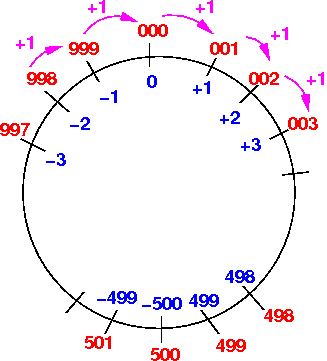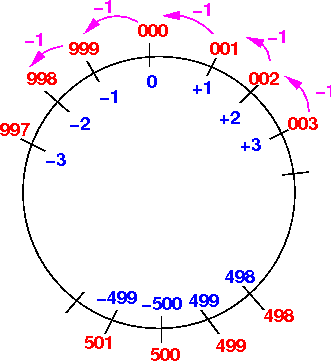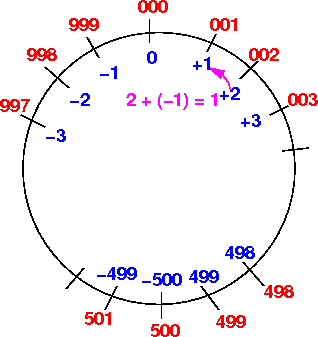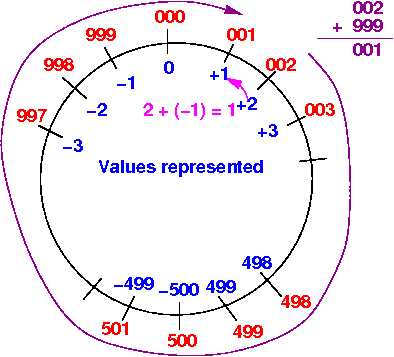|
The signed decimal code (or representation): (a sign-magnitude code)
Signed decimal code Represented signed value
... ...
-2 ••
-1 •
0
1 •
2 ••
... ...
|
Short-coming: the meaning of +/- operations depends on values of the operands
2 The + operation depends on the values
+ -1 of its operands
--------
1 (To obtain 1, we subtracted 2 and 1)
|
The 3 digit 10s complement code (or representation): (a sign-magnitude code)
3 digit 10s compl code Represented signed value
... ...
998 ••
999 •
000
001 •
002 ••
... ...
|
Advantage: when we compute 2 + −1 using the 3 digit 10s compl representation:
002 The + operation is independent from the values
+ 999 of its operands
--------
001 (To obtain the result, we added 002 and 999)
|
The 3 digit 10s complement code (or representation): (a sign-magnitude code)
3 digit 10s compl code Represented signed value
... ...
998 ••
999 •
000
001 •
002 ••
... ...
|
Subtraction works equally well: 3 − 4 = −1 is computed in 10s complement as follows:
003 (We can always borrow from a digit to the left)
- 004
-------
999 (999 represents the value -1)
|
Due to the limitation to only 3 digits, the signed values are mapped by the 3 digit 10s compl code on a circle:

Adding 1 to a 3 digit 10s compl code is moving clock-wise 1 position on the circle:

Subtracting 1 from a 3 digit 10s compl code is moving anti-clock-wise 1 position on the circle:

Suppose we compute: 2 + (−1) = 1 --- (note: + means: move forward (clock-wise))

How many positions forwards (= clock-wise) do we have to move to reach the position 001 on the circle ???
When we compute 2 + (−1) = 1 - we can move forward from 002 to 001 as follows:

We can move from 002 to 001 by going clock-wise 999 positions !!!
Therefore: by representing NEGATIVE ONE as 999, we will keep the meaning of + operation independent from the value of the operands !!!
BTW: truncating the carry digit in an addition is basically modular arithmetic